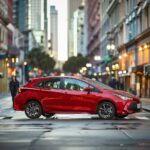Picture a world where your morning commute becomes productive time rather than a test of patience behind the wheel. You sip your coffee, check your schedule, or simply relax while your car smoothly navigates through traffic. This is not just a futuristic dream from science fiction. Self driving cars are steadily moving from prototypes to real-world roads, reshaping how society thinks about mobility, safety, and the very structure of cities.
The promise of self driving technology rests heavily on safety. Human error is responsible for the majority of road accidents. Fatigue, distraction, or impaired judgment often lead to outcomes that change lives in an instant. Autonomous systems powered by sensors, cameras, and advanced algorithms are designed to remove those risks. They can detect hazards faster than a human, maintain precise speed and distance, and remain consistently alert. If widely adopted, these vehicles could dramatically reduce accidents and save countless lives.
Beyond safety, the economic impact is equally significant. Consider the millions of hours people spend driving each year. Converting that time into productive or restful hours could boost efficiency across industries. Businesses might see employees arrive less stressed and more prepared. Families could enjoy more time together during long trips. The ripple effects stretch from personal wellbeing to national productivity.
Traffic flow is another area where self driving cars may bring transformation. Imagine roads where every vehicle communicates with others to avoid congestion. Autonomous cars can optimize routes in real time, keep consistent spacing, and coordinate entry into intersections without the stop-and-go chaos that currently wastes fuel and time. Cities struggling with gridlock may see improved air quality and reduced commute times once human driving habits no longer cause unpredictable slowdowns.
The technology also opens possibilities for those who currently face mobility challenges. Elderly individuals, people with disabilities, or those who cannot drive due to medical reasons could gain independence. Instead of relying on relatives, public transport schedules, or costly services, they could simply summon a vehicle that arrives and takes them where they need to go. That shift carries social as well as personal benefits, enabling greater participation in community and economic life.
However, the road toward this future is not without obstacles. Building trust in the technology remains critical. Every incident involving a self driving vehicle receives intense attention and often sparks public doubt. Developers must continue improving systems while also educating communities on how the technology works and where it stands today. The conversation about accountability is ongoing as well. If an autonomous car is involved in a crash, who holds responsibility: the manufacturer, the software developer, or the passenger? These questions must be addressed before self driving cars become mainstream.
The impact on employment is another factor shaping the debate. Professional drivers, from truckers to taxi operators, form a large workforce around the globe. As autonomous fleets expand, certain roles may shrink. At the same time, new opportunities will emerge in vehicle monitoring, software development, cybersecurity, and maintenance of advanced sensor systems. Preparing workers for this transition through training and education will be key to balancing progress with economic stability.
Urban planning could also undergo change. If cars can drop passengers off and then park themselves in optimized lots outside the city center, valuable downtown land may be freed up for housing, parks, or businesses. Reduced need for sprawling parking areas could reshape city landscapes, making them more pedestrian friendly and sustainable. Self driving vehicles integrated with electric technology may further accelerate the shift toward greener, cleaner cities.
For families and individuals, ownership models may evolve. Instead of each household owning multiple cars, ride hailing services with fleets of autonomous vehicles may become the norm. Cars would be available on demand, reducing costs for maintenance, insurance, and storage. This could particularly benefit urban dwellers who need reliable transport but do not wish to deal with the expense of ownership.
Self driving cars are not just about technology. They are about rethinking mobility and what it means to move safely and efficiently in the twenty-first century. The progress so far signals that while full autonomy may still take years to perfect, its influence is already being felt in how vehicles are designed and how cities prepare for the future.
The road ahead will require careful planning, regulation, and adaptation. Yet the potential rewards are extraordinary. From safer roads and cleaner cities to greater freedom for people who currently struggle with mobility, self driving cars are shaping a future that looks more connected, inclusive, and efficient than the world we know today.


